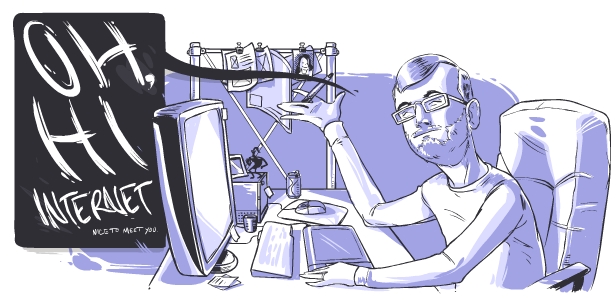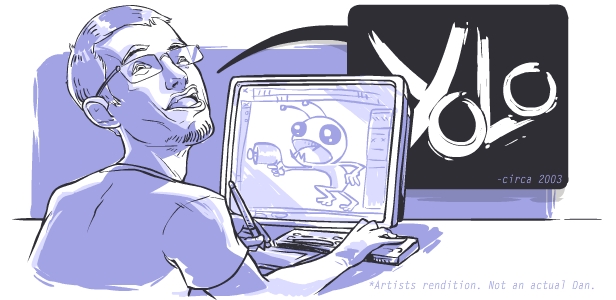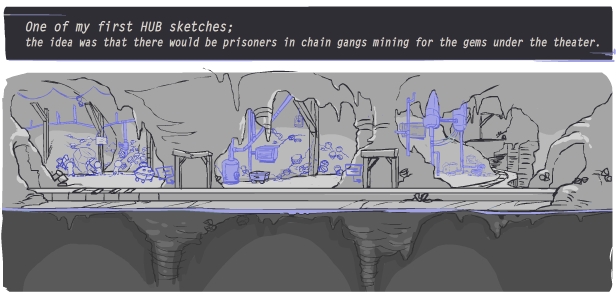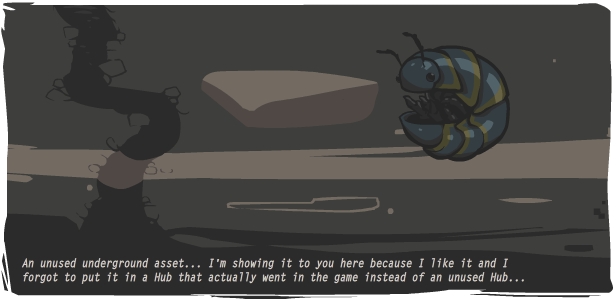What does it mean to be an artist at The Behemoth studio? Our newest artist in the development team, Eric Haddad, will go into detail about his process as an artist who worked on BattleBlock Theater:
Introduction

Oh, hello internet – I mean, people on the internet. My name is Eric Haddad. I’ve been in the art department at The Behemoth for about two years now. I’ve worked mostly on BattleBlock Theater (BBT) but also provide support for any other art needs for the folks here.
Today, I’m here to talk a little bit about the art production on BattleBlock Theater and a little about what it’s like working on a project that isn’t in the same art “style” as I would normally work in.
Notes on Style
First of all, because it’s a subject of interest and questions from many aspiring artists, I want to say a few things about style.
Quit worrying about style.
Seriously, if you want to be a good artist, if you want to have fun being a visual creator, just stop. Style will come naturally. Or it won’t. Screw it. If you want to be “marketable” a style can help but it isn’t necessary. Once you learn to draw well you’ll be able to mimic any style you want, just for fun. Or, in learning to draw well, you’ll come to find you actually do have a style of your own.
I recently heard a relevant quote that I liked from Robert Henri’s book, The Art Spirit:

Henri basically says we all struggle with trying to draw how we want, which sometimes conflicts with what we’ve seen before and liked. Or, it conflicts with what we perceive to be doing well in the industry. A good example of that is Dan’s own style. During the time Alien Hominid went hot potatoes, the industry was all ga-ga for 3D. Dan just drew how he liked to draw and it worked out well despite it being a 2D game.

Alright, I could go on about this for a while if I don’t stop myself, so, let’s move on.
Emulating Dan’s Style
When I started here at The Behemoth I had been a fan of Dan’s fun style for a long time (since playing Alien Hominid with my brothers on the GameCube back when I was in school for animation). I’d draw similarly to his art every now and again but it wasn’t my go-to for visual design to draw the way Dan does.
Once it was my job to draw the way Dan does, I started really breaking down what makes Dan’s style his style.
An artist’s style is really just the way they prefer to solve visual problems. Here’s an example of what I mean by “visual problem”- especially in video games and animation, the character needs to stand out from the background; some artists use thick black outlines to solve the problem, some use an outline of a darker color than the character’s color, some use no outlines and just balance the value, color and/or saturation of the backgrounds, many use a combination of these solutions. All options can look nice and effectively solve the same problem, but your choice on how to solve the problem helps define your style.
My task when I started working here was basically to look at how Dan solves those problems and fight my personal solutions in favor of Dan’s.
Other companies have style guides or model sheets to follow; we do not. Instead, the art direction is a lot more off the cuff, a lot more collaborative. I don’t mean to gush, but looking back on it, that was pretty awesome. I mean, here was this artist whose work I had enjoyed and respected for years, and now I was collaborating with him; pretty neat.
A lot of work was already sketched up or done on BattleBlock Theater when I started so I tried to use that as a sort of “style guide” without them being compiled into a guide. I also had to ask Dan a fair amount of questions and redraw a fair amount of work I did.
One of my first assignments was to tackle some background art for the Hubs in BBT. I tried to pay attention to Dan’s use of desaturated colors in the dingy old theater and his use of perspective in environments (which is pretty stylized and sometimes a little wacky… something I actually took a little while to get a handle on).

There’s a lot to consider when emulating an art style. Some of Dan’s style overlapped with what I enjoy doing, but some of it was hard to change. Especially because of how specific and simplified Dan’s shapes are. I tend to get a little more complicated with silhouettes (silhouettes are a big concern in art, it can be a great way to make sure your character or object can be immediately recognized if you can tell what it is based entirely on its outlining shape). I’ve since become a lot more used to simplifying my shapes the way Dan does, but it’s still probably the one aspect of emulating his style that I struggle with most.
Conclusion
So there’s a little bit of knowledge all up on you, but not too much. I hope you enjoyed this little write up and I’ll leave you with a super secret special drawing of something I drew for that cave Hub that was never completed and never used because the story was better told with different Hubs. Enjoy and goodbye!

–Eric
